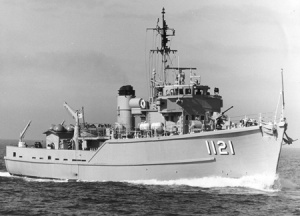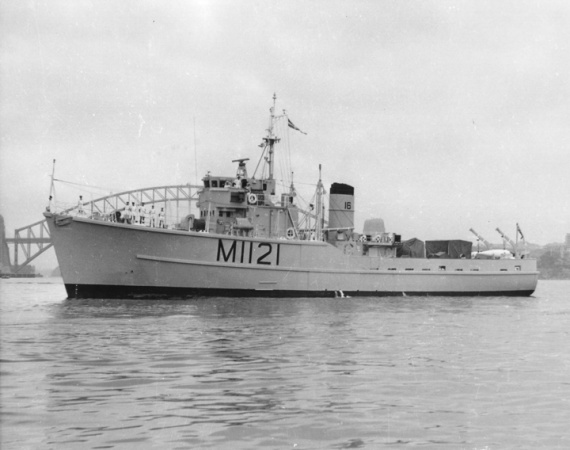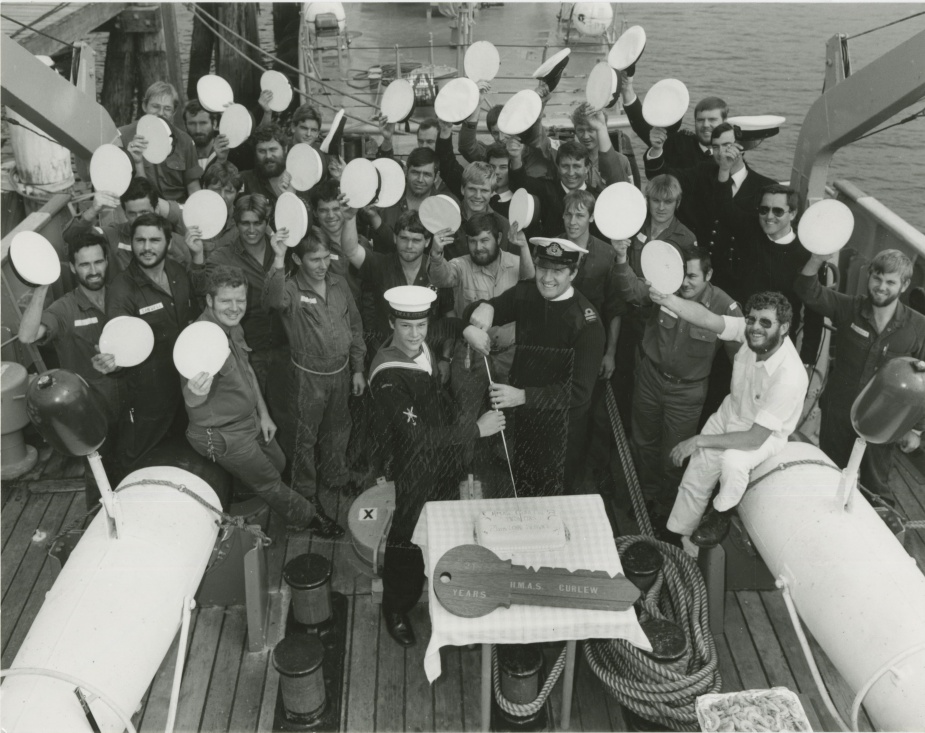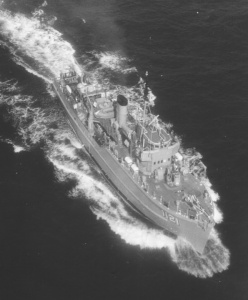HMAS Curlew
| Class |
Ton Class |
|---|---|
| Type |
Minesweeper |
| Pennant |
M1121 |
| Builder |
Montrose Shipyard |
| Launched |
6 October 1953 |
| Commissioned |
12 August 1962 |
| Decommissioned |
30 April 1990 |
| Dimensions & Displacement | |
| Displacement |
|
| Length | 46.6 metres (152 feet) |
| Beam | 8.8 metres (29 feet) |
| Draught | 2.5 metres (8 feet) |
| Performance | |
| Speed | 15 knots |
| Complement | |
| Crew |
|
| Propulsion | |
| Machinery | 2 Napier Deltic Diesels |
| Horsepower | 3000 |
| Armament | |
| Guns | 2 single 40/60 Bofors (1 single 40/60 Bofors from 1968) |
| Awards | |
| Battle Honours | MALAYSIA 1964-66 |

HMAS Curlew was one of six ex-Royal Navy Ton Class minesweepers acquired by the Royal Australian Navy (RAN) in the 1960s. Her sister ships were HMA Ships Hawk, Gull, Snipe, Ibis and Teal. The six Ton Class minesweepers formed the 16th Mine Countermeasures (MCM) Squadron and provided the RAN with the means to gain and maintain proficiency in mine countermeasures.
Curlew was accepted into service with the Royal Navy on 28 September 1954 as HMS Chediston. She was renamed HMS Montrose and, from 11 August 1955 to October 1957, was used by the Tay Division of the Royal Navy Volunteer Reserve. Subsequently, she reverted to her former name and was placed in storage until purchased by the RAN.
Commissioned as HMAS Curlew on 12 August 1962, under the command of Lieutenant PH James, RAN, and arrived in Sydney with her sister ships on 7 December 1962.
After sea trials in early 1963 and a further refit at Garden Island Dockyard, including the fitting of two 40/60 Bofors mounts, Curlew rejoined the 16th MCM Squadron on 6 May 1963, conducting a routine exercise, maintenance and inspection programme until September 1963.
On 20 September 1963, Curlew and her sister ships sailed for their first overseas deployment as part of Operation GARDENING, a minesweeping task to clear a channel into Tonolei Harbour in Bougainville, where US aircraft had dropped a large number of magnetic mines in 1943. This was the RAN's biggest minesweeping operation for 16 years. The deployment also included overseas port visits to Singapore and Port Moresby, and the conduct of hydrographic surveys in the Solomon Sea and Chestnut Bay (125 miles south east of Port Moresby). The Squadron returned to Sydney that December.
Curlew participated in mine countermeasures exercises in Australian waters from late January 1964, however, these were suspended briefly from 11-13 February when she assisted in the search for survivors from the Melbourne/Voyager disaster. Curlew sailed for her first Far East Strategic Reserve (FESR) deployment in company with Snipe at the end of May to support anti-infiltration patrols in Malaysian waters. On her return to Sydney in February 1965, Curlew entered a refit at Garden Island Dockyard during which her hull was fibreglassed; the first time this had been done to a hull of this size.
Following almost 6 months in dock Curlew commenced her second FESR deployment in September 1965, once again in company with Snipe, remaining deployed until the end of the Indonesian Confrontation in August 1966. By the time she returned home in early December 1966, Curlew had steamed approximately 56,000 nautical miles on active service in her second FESR deployment.
Curlew decommissioned on 19 December 1966 for conversion into the RAN’s first Minehunter. The main elements of this conversion included fitting a Plessey A/S 193 high definition short range sonar into her existing dome space as part of the Mine-hunting System (Acoustic) Mark 1 (MHSA 1); modernising the bridge and operations room; removing the influence minesweeping systems; fitting a one-man recompression chamber; and replacing the existing rudders with active rudders. As a result of her conversion, Curlew’s complement was decreased from 38 to 31; 3 officers and 28 sailors, including a Clearance Diving Team.
Curlew recommissioned on 13 December 1968 under the command of Lieutenant Commander BA Willcox, RAN, however, she remained at the Gun Wharf, Garden Island, until February 1969 with refit works continuing. Curlew, in company with Hawk and Gull, deployed for the Far East on 17 March 1969. The three ships took the more circuitous route along Australia’s southern coastline enabling them to survey an approach channel off Anglesea, Victoria. They arrived in Singapore on 21 April to participate in Exercise JUGGLER in East Malaysian waters with units from the Royal Navy and Royal Malaysian Navy, and the South East Asia Treaty Organisation Exercise SEA SPIRIT involving more than 60 naval units from Australia, New Zealand, the Philippines, Thailand, the United Kingdom and the United States. On 3 June 1969, the SEATO exercise was postponed following the HMAS Melbourne/USS Frank E Evans collision. The mine countermeasures phase of the exercise recommenced the following day. Curlew arrived home on 1 July.
For the remainder of the year Curlew operated in Australian waters conducting a routine exercise, maintenance and inspection programme. During 25-28 August 1969, together with other RAN units, she was involved in a search for survivors from the merchant vessel, Noongah, which had foundered in heavy seas off Smoky Cape.
Curlew once again deployed for the Far East, in company with Teal and Ibis, on 30 April 1970. During this deployment she participated in Exercises CRACKSHOT and BERSATU PADU, with more than 30 ships of the Australian, British, Malaysian and New Zealand Navies. She returned to Sydney on 27 July 1970 and spent the rest of the year operating on the east coast of Australia.
Curlew deployed to Papua New Guinea in company with Hawk and Snipe in late May 1971 to commence a Mine Warfare Pilotage Survey and South West Pacific deployment during which they provided aid to the civil power in New Britain, Rabaul, in the aftermath of an earthquake. She entered a seven month refit upon returning to Australia in November.
Following refit, Curlew commenced a four and a half month Far East deployment on 26 June 1972, in company with Snipe and Teal, during which they conducted general survey duties, cleared a WWII minefield in the vicinity of Port Moresby and participated in the SEATO Exercise SEA SCORPION. During this deployment Curlew and Snipe were called upon to search the waters off Penang to locate the remains of a Royal Malaysian Air Force Sabre jet fighter which had crashed in the sea after the pilot had been forced to eject. After an eleven hour search, Curlew located the wreckage of the aircraft in 32 feet of water.
Upon her return, Curlew remained in Australian waters until 1975, conducting a routine exercise and maintenance programme, including participation in Exercise KANGAROO ONE in June 1974.
Curlew once again deployed to Papua New Guinea in March 1975 in company with Ibis and Snipe, to contribute to Operation STILL DUSTY to clear mines laid by Australian forces during WWII in Bootless Inlet, near Port Moresby and which now impeded the laying of a submarine telecommunications cable between Port Moresby and Cairns. Post-war minesweeping had rendered the area safe for surface navigation, but not for cable-laying or other underwater activities. This was the largest mine-hunting operation by the RAN to date which involved the detection and clearing of mines from an area of 12 square kilometres by the end of April.
Curlew returned to Australian waters in May 1975 and commenced survey operations, most notably in the approaches to Darwin in the aftermath of Cyclone Tracy. During the month long operation, several sunken trawlers and other navigational hazards were located, most of them victims of the Cyclone, and whose fate had previously been unknown. In August 1975, she entered a year long refit at Garden Island Dockyard, emerging in time to participate in Exercise KANGAROO TWO during October 1976.
In January 1977, Curlew commenced a four month circumnavigation of Australia in company with Ibis gathering oceanographic data for the RAN Research Laboratory. She once again spent the second half of the year in refit.
In addition to routine exercises and survey work during 1978, Curlew apprehended an illegal Japanese fishing vessel, Eikuku Maru No 71 in February; starred in segments of the Australian television series 'The Sullivans'; and completed a second circumnavigation of Australia. In October, Curlew participated in Exercise LONGEX 78 in New Zealand waters which included naval units from Australia, New Zealand and the United States, and assisted with the salvage of a Royal Australian Air Force (RAAF) F111 which had gone down off the New Zealand coast. She ended the year as the winner of the Kelly Shield, the annual efficiency award for small ships in the RAN.
Following another refit, Curlew deployed in company with Snipe in July 1979 to conduct survey work in Northern Australian waters. In nine days of surveying, Curlew and Snipe completed 3053 miles of soundings compared to 2853 miles by three MCM vessels in 1978. A subsequent deployment to Indonesia was cancelled so Curlew and Snipe undertook a brief visit to Port Moresby in August instead. That October, Curlew participated in Exercise KANGAROO THREE, following which she returned to Sydney to prepare for an unscheduled docking as the propeller shaft on her starboard active rudder had sheared during the deployment.
In February 1980, Curlew, Ibis and Snipe visited Tasmania to participate in festivities for the Hobart Regatta as well as undertaking mine countermeasures exercises including a team sweep along the northern Tasmanian coast. This sweep of 90 miles in 40 hours was the longest sweep attempted since WWII and was a record for RAN Ton Class MCMs. The trio followed this with a South West Pacific deployment from March to June which included visits to Port Moresby, Lombrum, Rabaul, Port Vila, Suva and Noumea, as well as exercises with the Papua New Guinean, Fijian and French navies. Curlew and Snipe returned to the South West Pacific in June 1981, however, this programmed two month deployment ended abruptly on 3 July when Snipe ran aground on a coral reef while entering Nuku’Alofa harbour. Snipe was re-floated within hours but spent eight days in Tonga undergoing repairs.
Curlew participated in Exercise KANGAROO 81 in October/November 1981, at the conclusion of which she was tasked to survey the wreck of SS Trinity Bay in the vicinity of Cairns to recover unexploded ordnance from inside the vessel after it was sunk by RAAF aircraft the previous week.
Curlew started 1982 exercising in Australian waters before entering a refit in March to July 1982 and a visit to Port Moresby in November in company with Snipe. Curlew participated in the Fleet Concentration Period in February of 1983, followed by Exercise SEA EAGLE 83 in February/March. Upon completion Curlew and Ibis conducted mine warfare pilot surveys in Australian waters before deploying to South East Asia and conducting the first ever mine countermeasures exercises between Australian and Indonesian forces. Tragically, upon returning to Australia, Curlew Executive Officer, Lieutenant E Callister, died in a diving accident on 1 July 1983, during a survey off Townsville.
On 3 June 1983 Snipe was decommissioned making Curlew the oldest serving ship in the RAN celebrating 21 years of service on 21 August 1983. She participated in the Fleet Concentration Period that month before conducting mine warfare pilot surveys, in company with Ibis, around the East Australian coast. During the surveys, she lost her port active rudder propeller when the retaining mechanism sheared. She returned to Sydney on 4 November 1983, and began refit preparations.
Ibis paid off into the Reserve Fleet on 4 May 1984, so when Curlew emerged from refit on 18 June, she was the RAN’s only remaining MCM vessel. She once again participated in the Fleet Concentration Period in September before a two-month deployment to Darwin which included participation in Exercise NEW HORIZON with the Indonesian Navy. She made another brief port visit to Port Moresby, her last overseas deployment, before arriving back in Sydney on 10 December.
Curlew spent the last six years of her service in Australian waters conducting exercises, survey work and participating in trials for the new Mine Hunter Inshore vessels. During October 1985 she took part in a search for the wreckage of a jet freighter aircraft which had crashed into the sea off Sydney using her high definition sonar and Super Dart submersible. In February 1989, Curlew became the training ship for sailors from the newly formed Mine Warfare Category undergoing training at HMAS Waterhen.
Curlew was decommissioned on 30 April 1990 after 28 years of service and 38 years to the day after her keel had been laid. She had steamed more than 400,000 nautical miles in 40,000 hours underway. Curlew remained in the Reserve Fleet until she was sold on 17 June 1991.










